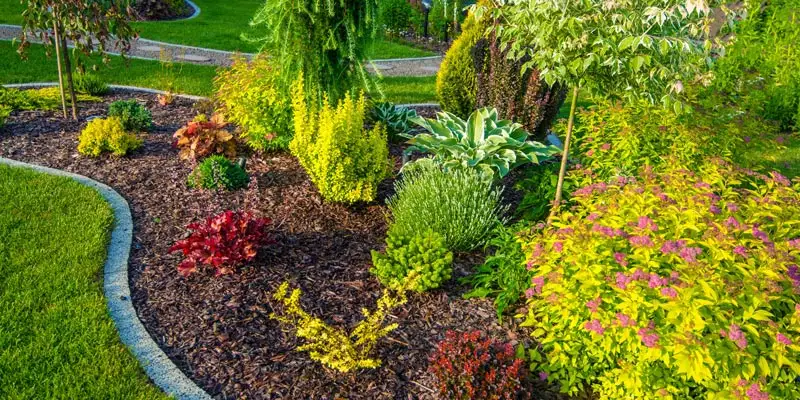The Facts About Landscape Design Revealed
Table of ContentsLandscape Design for DummiesThe 5-Minute Rule for Landscape DesignFacts About Landscape Design UncoveredLandscape Design for Beginners
Formal style theme. Debt: Gail Hansen, UF/IFAS The lawn is an expansion of the home where a variety of activities happen. A yard can normally be separated into 3 locations: public (the front yard), personal (the garden), and service (commonly the side yard). The area of task locations depends primarily on the sort of area, the dimension of room required, the kind of task, and the preferred distance to various other activities and structures (Landscape Design).
The outdoors wall surface of your home commonly functions as the first wall or starting factor of an outdoor area. Incompatible uses should be separated, and related tasks, such as food preparation and eating, ought to be placed with each other to make the backyard extra efficient and satisfying. When using hardscape to create rooms, use building and construction product similar to that used in your house for connection from your home into the yard.
Linked spaces. Credit Score: Gail Hansen, UF/IFAS Making use of similar hardscape functions and duplicating plants pulls the eye around the garden.
From a style viewpoint, plant products have three significant features in the landscape: aesthetic, architectural and practical. Cosmetically, plants produce an aesthetically positive setting and structurally plants organize and define rooms.
9 Easy Facts About Landscape Design Shown
For psychological convenience plants are used as physical or suggested obstacles for personal privacy and safety and security. Physical barriers block both the sight and accessibility to a room and include fencings, walls and plant hedges. Landscape Design. Indicated obstacles, generally low growing plants, obstruct gain access to however not the sight (Number 9). Various other functions of plants consist of cleaning the air, stopping erosion and dirt loss, keeping wetness in the dirt, and returning raw material to the soil.
Physical and suggested barriers. Credit History: Gail Hansen, UF/IFAS For these reasons, the sorts of plants to be utilized (such as trees, hedges, or groundcovers) should be selected in the onset of preparation. Plant kinds are picked for their useful capabilities to make sure that their future function and required room can be taken into consideration at the same time.
The overhanging plane, the vertical airplane and the ground airplane should all be taken into consideration to create room. When the shape of a plant bed has been developed, the go to this web-site plants should be massed (organized) and layered to attain visual unity and the wanted quantity of unit. The size of a plant mass will certainly rely on the overall dimension of the backyard, the size of the private plants in the mass, and the focus or impact preferred from the plant product.
Each plant mass is in front of, behind, or beside, one more mass. Figure 11. Straight plant layers. Credit: Gail Hansen, UF/IFAS Figure 12. Upright plant layers. Credit: Gail Hansen, UF/IFAS Repeating plants within a mass and repeating masses with comparable plants ties the garden together. The specific plant characteristics must be thought about to effectively layer and mass plants.
About Landscape Design
All plant compositions begin with the primary structure plants, the big, mostly evergreen history plants-such as the trees and big bushes. These plants different or enframe areas, regulate the dimension of the space, and provide the starting factor for choosing the appropriate qualities of the second layer, midground plants, for massing and infill.
Crucial points in the garden must be highlighted by the use one-of-a-kind plants, distinctive frameworks, or garden ornaments. Noting limits or entrances to rooms can be made with gates, arbors, and actions, or through using one-of-a-kind and colorful plants. The type and/or style motif of the yard will certainly often aid establish the crucial factors and just how they ought to be highlighted.
Various other important places in the lawn are centerpieces, which is made use of to aesthetically arrange a landscaped location. The type of prime focus frequently relies on the watching internet point of view. Different perspectives or point of views can reveal various compositions in the landscape that might call for a range of focal points. Contrasting structure, form, dimension and shade will catch and hold the eye.
The Greatest Guide To Landscape Design
Figure 13. Plant kinds. Credit Report: Gail Hansen, UF/IFAS After form, structure is the following dominant function of a plant; crude, medium and great structures can be made use of for contrast and emphasis in the landscape. Kind and texture both trump color in the yard for the majority of the year. However, during particular seasons, shade will be the most obvious characteristic of the garden.


The positive scent of plants, the noise of wind in the trees, the noise and structure of water, and the shades and appearances of sculptures, pots and yard furnishings all contribute to the experience of the garden. One detail that is frequently overlooked is the impact of light on the aesthetic appeals of the plants.
The whole garden changes in feature and appearance throughout the day, and the training course of a year, as the light and temperature modification from early my latest blog post morning to night and season to period. Plant option should take into consideration a plant's development rate, its mature dimension and type, and the maintenance it will need.
It is very important to understand the eventual fully grown size of plants so they can be put in the right location and spaced properly when they are installed. Providing plants space to grow is a challenge since the typical mature dimension is typically based upon ideal growing problems and the ecological problems of a site may create a plant to enlarge or remain smaller.